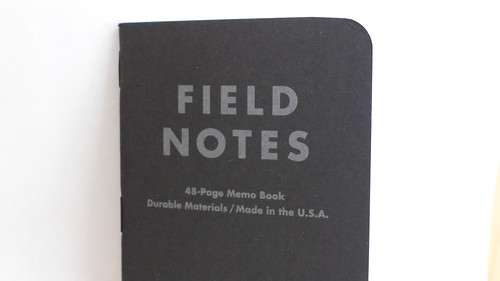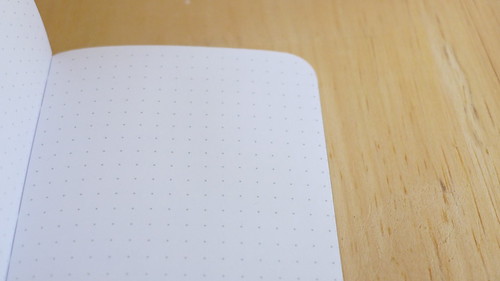Field Notes Pitch Black Review
"Black as midnight, black as pitch, blacker than the foulest witch..."
--Blix, Legend
Okay so it is a horrible movie, but I was always taken by the quote, even my twelve year old self thought it sounded cool.
At this point is probably wholly unnecessary to do a review on Field Notes notebooks, but I got the new black standard edition and it has been great to use. As such, I thought I'd pass the word along.
--Blix, Legend
Okay so it is a horrible movie, but I was always taken by the quote, even my twelve year old self thought it sounded cool.
At this point is probably wholly unnecessary to do a review on Field Notes notebooks, but I got the new black standard edition and it has been great to use. As such, I thought I'd pass the word along.
Here is the product page. There is no written review yet. The three pack of 48 page notebooks costs $10. I received my three pack of black Field Notes from E2Field Gear. You can go there using the banner on the right and use the discount code for 8% off. All proceeds benefit the site and its giveaways.
They were purchased with site money, but obvious I can't both test them and then give them away (used Field Notes aren't so popular), so I am keeping them. Honestly, this single point is why it took me so long to review these gems. They fundamentally break a rule about keeping stuff purchased with site money, but I made an exception for two reasons: 1) it seems like a pretty important EDC related product and skipping a review does you a disservice; 2) they represent a very small purchase, so it won't take away from big giveaways in the least. I hope you don't mind. If you do, let me know in the comments. This stuff really does bother me, so I want to hear what you think, either way.
Field Notes are a small paper notebook, very similar to the Moleskine Cahier. They have a cardboard cover and excellent paper inside. The overall construction is simple and the books are designed for everyday carry (hence their inclusion in the reviews section of this site). They are throwbacks to old garage journals that were issued in the 30s, 40s, and 50s. They'd have a nice thick cover with a logo or some folksy image and they'd have a few black pages on the inside to write stuff down in. You could easily drop a Field Notes notebook in your back pocket with a wallet and never really notice the additional weight or even the fact that it was there.
The paper in the Pitch Black Field Notes is Finch Paper Opaque Smooth 50#T "Bright White", with a fine, 1-color application of light gray soy-based Toyo Ink. That's a lot of tech specs for paper, most of which I don't think are absolutely essential to know, but I'd rather they give us this information than not. If this notebook was made by Gerber, the paper would be listed as "white paper" akin to their claim of "stainless steel" for the tools and implements found on their multitools. In use, the paper is very nice and plenty thick for even bold lines. I wouldn't recommend it for a fountain pen but for other kinds of pens, especially ball points, it is more than fine. The paper is smooth and without defect. It does not allow much if any ink bloom or feathering (unless you use a fountain pen) and it is look very white without being offensively bright. Most of my use has been with either a Lami Safari or the Mont Blanc Fineliner refill in my Prometheus Alpha Pen. Overall, I like it and it blows the Moleskine paper out of the water.

There are dozens of special editions and they have become collectibles, find out more about them here. The original Butcher Blue limited release sells for more than $100 for a 3 pack, and recent eBay auctions have ended with prices in the $400 range. Here is a listing of all Colors Edition Limited Edition books. The black regular edition is very similar to the Night Sky limited edition, which was very popular and sold out quickly.
The paper in the Pitch Black Field Notes is Finch Paper Opaque Smooth 50#T "Bright White", with a fine, 1-color application of light gray soy-based Toyo Ink. That's a lot of tech specs for paper, most of which I don't think are absolutely essential to know, but I'd rather they give us this information than not. If this notebook was made by Gerber, the paper would be listed as "white paper" akin to their claim of "stainless steel" for the tools and implements found on their multitools. In use, the paper is very nice and plenty thick for even bold lines. I wouldn't recommend it for a fountain pen but for other kinds of pens, especially ball points, it is more than fine. The paper is smooth and without defect. It does not allow much if any ink bloom or feathering (unless you use a fountain pen) and it is look very white without being offensively bright. Most of my use has been with either a Lami Safari or the Mont Blanc Fineliner refill in my Prometheus Alpha Pen. Overall, I like it and it blows the Moleskine paper out of the water.

There are dozens of special editions and they have become collectibles, find out more about them here. The original Butcher Blue limited release sells for more than $100 for a 3 pack, and recent eBay auctions have ended with prices in the $400 range. Here is a listing of all Colors Edition Limited Edition books. The black regular edition is very similar to the Night Sky limited edition, which was very popular and sold out quickly.
Small notebooks like this offer a great deal of utility. As Andrew put in a recent podcast, the fact you don't need batteries to run these things is great when you are out of range and your iPhone/Evernotes combo can't help you. I have also found it is nice for storing notes about computer passwords, as it gives you a physical copy, something that does not, itself require a password. Additionally, unlike the thick oil paper or leatherette journals from Moleskine and others, the Field Notes books easily slide into a pocket and go unnoticed, ready for you to jot down a quick reminder.
The black edition has a dot grid pattern instead of normal lines.

I'd prefer lines, but the artists out there or the engineers probably appreciate the dot grid matrix. The paper in Field Notes changes from edition to edition and the paper used in the black regular edition is excellent. It is smooth and works exceedingly well with ballpoint pens and my Fineliner refill in the Alpha Pen. It does not do as well with a fountain pen, but much better than the Moleskines I have used.

I'd prefer lines, but the artists out there or the engineers probably appreciate the dot grid matrix. The paper in Field Notes changes from edition to edition and the paper used in the black regular edition is excellent. It is smooth and works exceedingly well with ballpoint pens and my Fineliner refill in the Alpha Pen. It does not do as well with a fountain pen, but much better than the Moleskines I have used.
Overall, I like the Field Notes format. It is very slim and easy to write on with a variety of pens. Fisher refills work very well. I am not sure I'd ever need a subscription, called the Colors Subscription, as I just don't have that many written notes I need to make, but overall, a three pack once a year seems like a very good purchase. They are not water proof or tear resistant, but they are pretty durable given the materials used. I gave one to my three year old and it has held up well. You'd never know he was the Tasmanian Devil that he is just by looking at the notebook. Here is the spine of his book after about three weeks of (ab)use:

Go give them a try. They are cheap, well made, and made in the USA. They work with a bunch of different kinds of ink and the paper is a noticeable upgrade from the junk found in Moleskines.

Go give them a try. They are cheap, well made, and made in the USA. They work with a bunch of different kinds of ink and the paper is a noticeable upgrade from the junk found in Moleskines.
